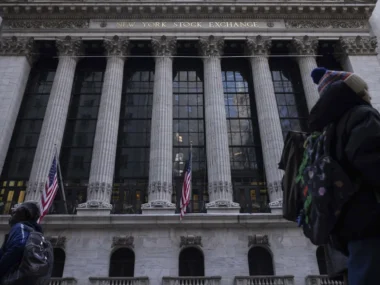The U.S. economy began 2025 by adding 143,000 jobs in January, fewer than anticipated, but the unemployment rate fell to 4%, according to Friday’s Bureau of Labor Statistics report.
Economists had expected the unemployment rate to stay at 4.1%, with 170,000 jobs being added, based on FactSet estimates.
The report, which also included significant data revisions that occur at the start of each year, shed light on recent labor market trends, showing that job growth in 2024 was weaker than initially thought.
The annual benchmark revision revealed that 589,000 fewer jobs were added in 2024 than previously estimated. After accounting for these adjustments, nearly 2 million jobs were added last year, averaging about 166,000 per month—nearly identical to the 165,000 average monthly gains in 2019.
Cory Stahle, an economist at Indeed Hiring Lab, commented that “the foundation of the labor market remains incredibly sturdy.” While revisions may have shifted some previous data, they did not alter the overall outlook. Despite the slowdown in job growth following the pandemic, the labor market has remained resilient enough to support consumer spending and set the economy up for a “soft landing,” controlling inflation without triggering a recession.
Additionally, the U.S. has experienced 49 consecutive months of job gains, marking the second-longest employment expansion streak in history, according to BLS data dating back to 1939. The longest streak was 113 months, from October 2010 to February 2020.
The impact of wildfires and weather events
In January, healthcare and social assistance sectors led job growth, contributing nearly half of the month’s total with a net gain of 66,000 jobs. The retail and government sectors (federal, state, and local) followed with employment increases of 34,300 and 32,000, respectively.
While most industries saw job growth, some gains were modest. Diane Swonk, chief economist at KPMG, explained that cold weather, illnesses, and the wildfires in Los Angeles likely impacted job growth for the month.
Swonk observed key shifts in underlying data, including a decline in leisure and hospitality jobs, an increase in absences due to illness or weather, and a drop in workforce participation among prime-age women. She pointed out that during disasters, women with young children often struggle without additional help. Although BLS officials acknowledged the wildfires and weather in their report, they indicated there was “no discernible effect.”
Economists suggest this may be BLS jargon, meaning the surveys of establishments and households were largely unaffected. Josh Hirt, senior economist at Vanguard, estimated the wildfires may have led to a reduction of about 15,000 jobs.
After removing some of the weather- and disaster-related disruptions from January and recent months, the labor market remains “very healthy” and stable, according to Hirt. Job gains for November and December were revised upward by a total of 100,000, reflecting a recovery from the hurricane and strike-related slump in October.
Hirt emphasized the typical volatility of monthly payroll numbers, but noted that over the last four months, the labor market has averaged nearly 200,000 job additions per month.
Wage growth continued to be strong, rising 0.5% from December and maintaining a 4.1% annual growth rate. This strong monthly increase might reflect the typical wage “reset” that occurs in January.
The labor market remains strong… for the time being.
Job growth has slowed over the past year, which was expected given the unsustainable pace of the pandemic recovery and the Federal Reserve’s high interest rates aimed at controlling inflation. However, a troubling trend has emerged in recent months: the turnover vital for a healthy labor market has significantly slowed. Companies aren’t hiring as much, workers are less inclined to quit, and jobseekers are staying on the sidelines longer.
Oliver Allen, senior U.S. economist at Pantheon Macroeconomics, warned that this slowdown leaves the market vulnerable to a rapid shift, with companies already hiring as though they’re in a recession, even if they’re not yet laying off workers.
The potential for a major change has increased with President Donald Trump’s sweeping policy changes on trade, immigration, federal employment cuts, and a crackdown on diversity, equity, and inclusion efforts. Michelle Holder, associate professor of economics at John Jay College, noted that these policies could reverse the employment gains made by women, Black workers, Latino workers, and other underrepresented groups.
Holder explained that tariffs raise prices, which leads to decreased spending, especially in sectors where Black and Brown workers are highly represented. Additionally, reducing the federal workforce could disproportionately affect Black workers, who are employed at higher rates in government positions compared to the private sector.
She concluded that the economic opportunities that were available to these groups during the post-pandemic recovery are now at risk, and the future doesn’t look as promising for these communities.
Regarding all those revisions…
January jobs reports can be complex due to established data adjustments that account for more up-to-date and comprehensive information.
First, seasonal adjustment factors play a role. Every January, many workers lose their jobs as the holiday season ends and businesses tighten their belts at the start of the year. These adjustments help smooth the data to reveal underlying trends. If fewer workers are let go than expected, it can lead to larger-than-anticipated job gains, and vice versa.
Second, there’s the annual benchmark revision to past payroll data. This process, done for the past two decades, involves reconciling preliminary employment estimates based on surveys with the more accurate data from unemployment insurance tax filings, which are slower to arrive.
The August preliminary benchmark suggested a possible revision of -818,000 jobs from April 2023 to March 2024, expected to be the largest revision since 2009. These large revisions often occur during significant economic transitions, such as the Great Recession or the pandemic. The surge in immigration has also influenced the data, economists note.
The establishment survey collects data from businesses on their employment levels, while unemployment insurance forms require names and social security numbers for verification. According to Ron Hetrick, senior labor economist at Lightcast, these revisions aren’t surprising when considering the data’s context.
On Friday, the final benchmark revision showed a reduction of 589,000 jobs, a smaller revision than anticipated, influenced by data from the Quarterly Census of Employment and Wages reports.
Lastly, new population estimates from the Census, another annual adjustment, are included in the household side of the employment report. These adjustments impact labor force characteristics and key metrics, like the unemployment rate.











